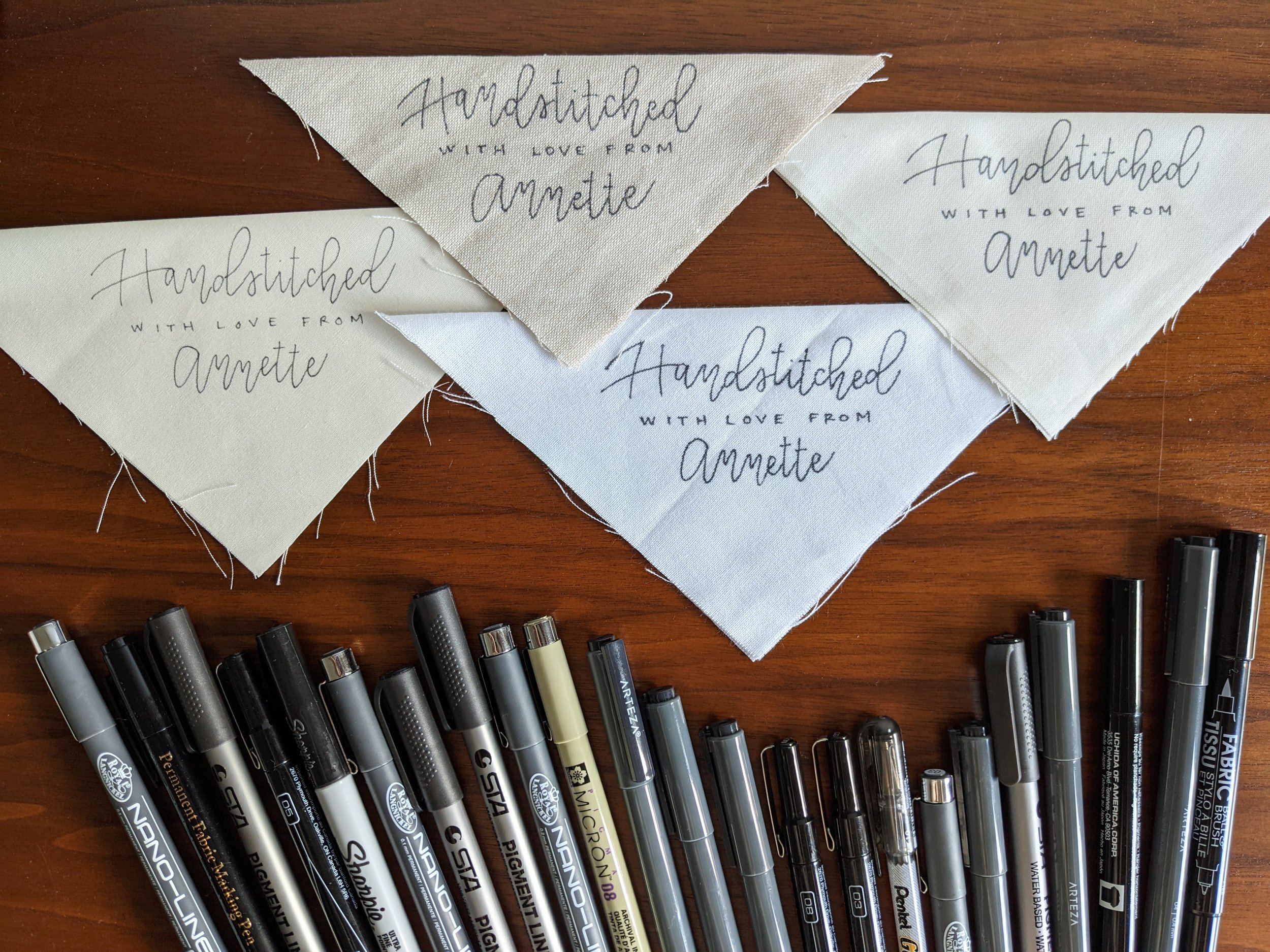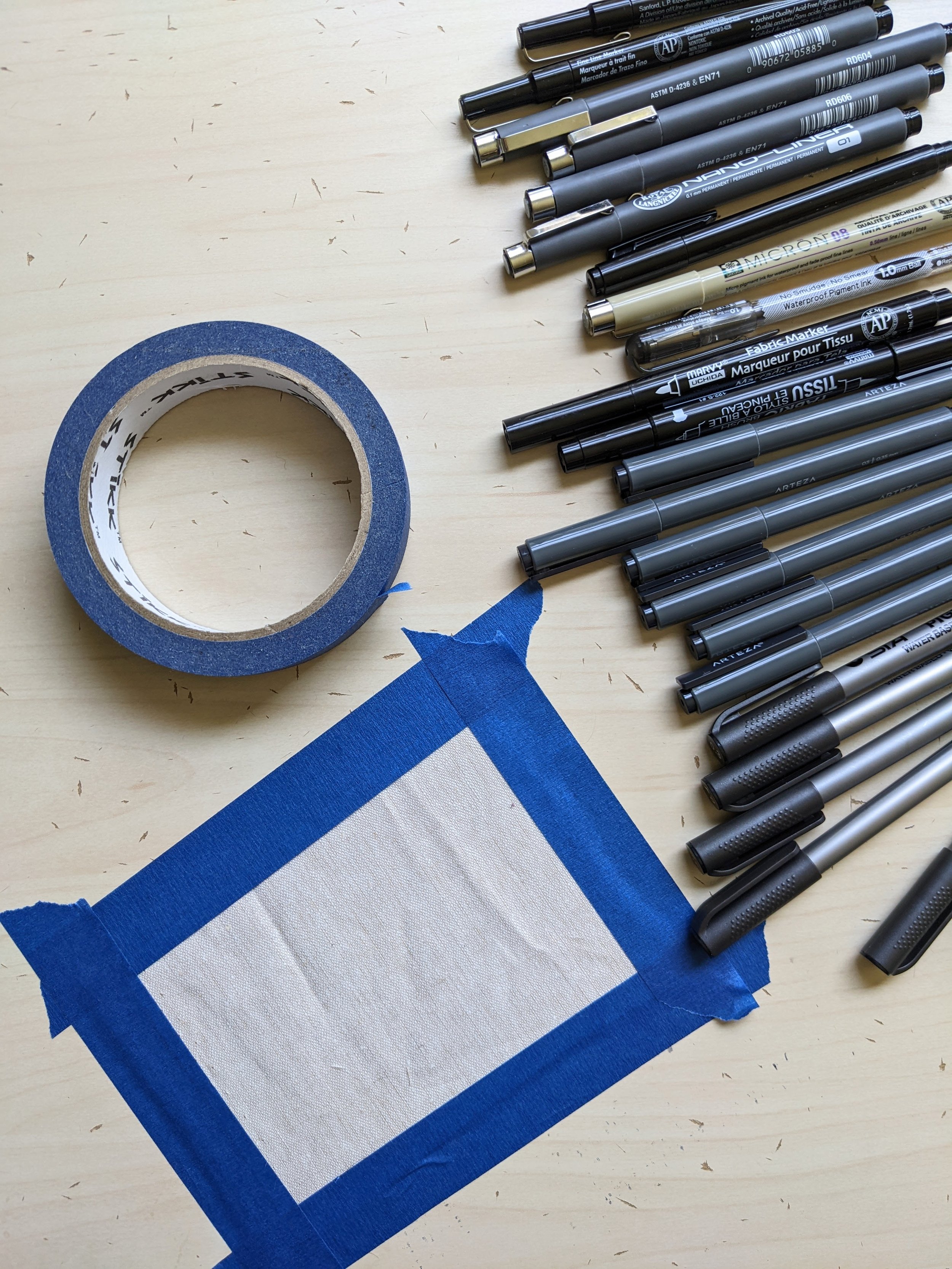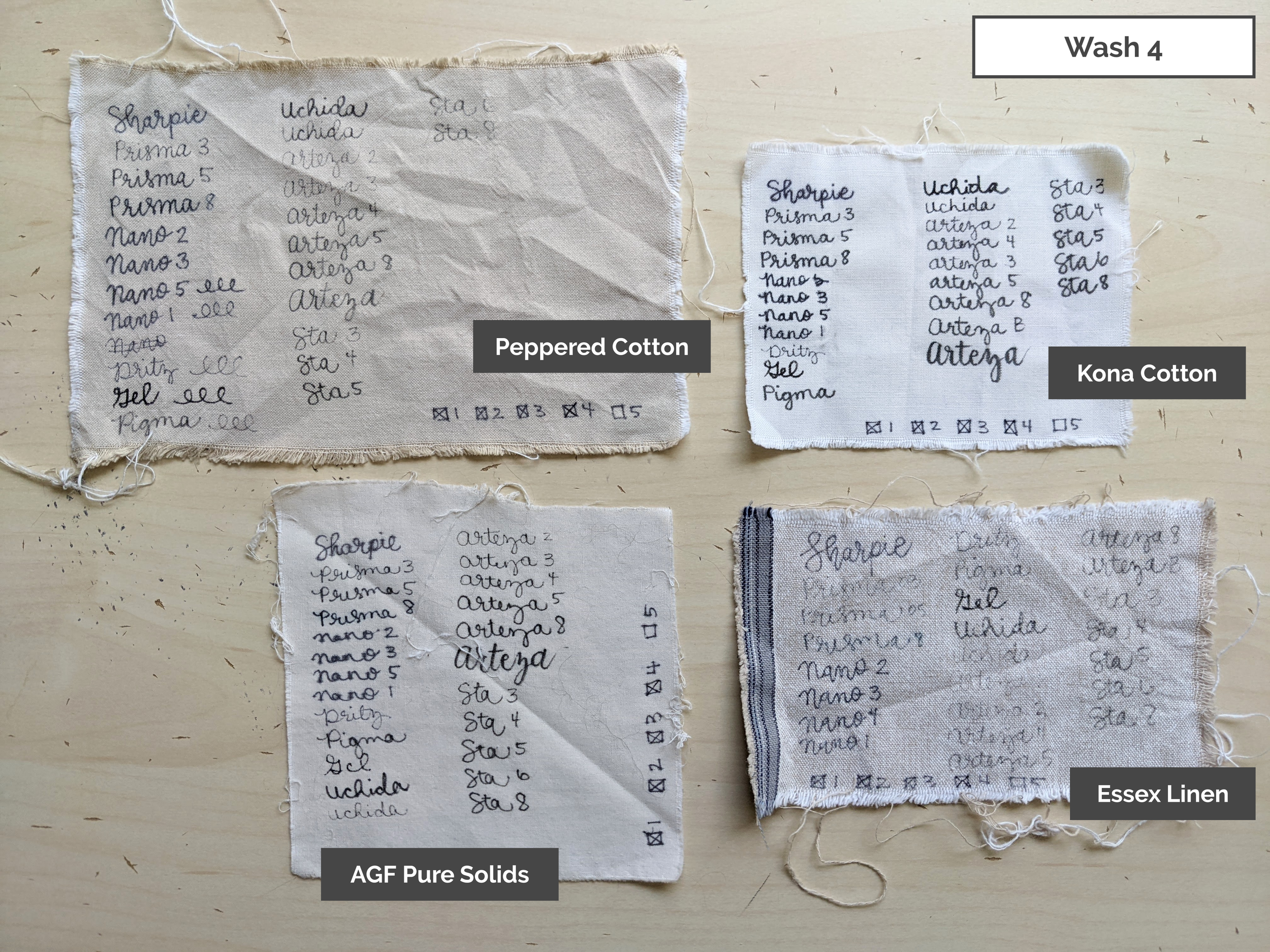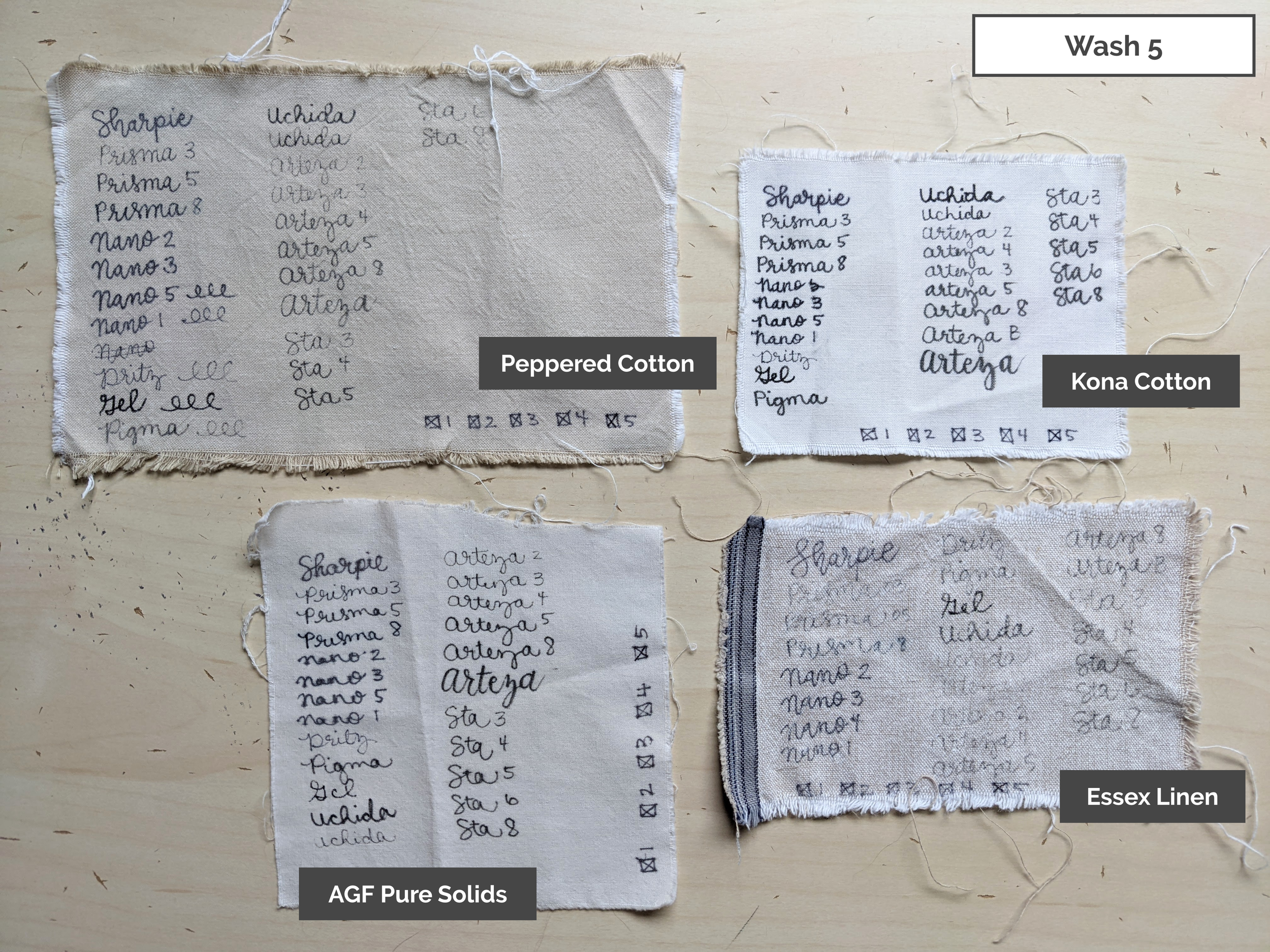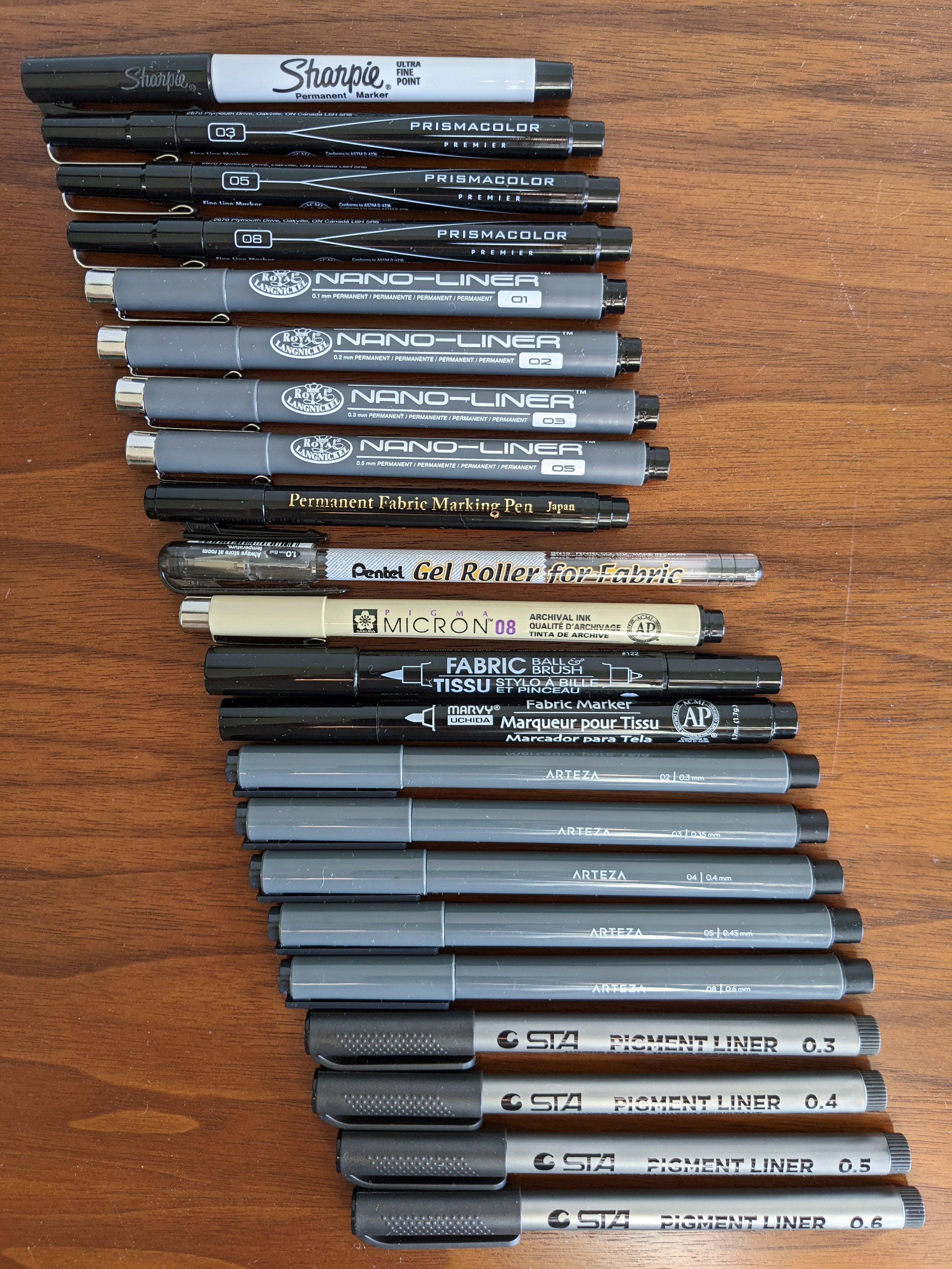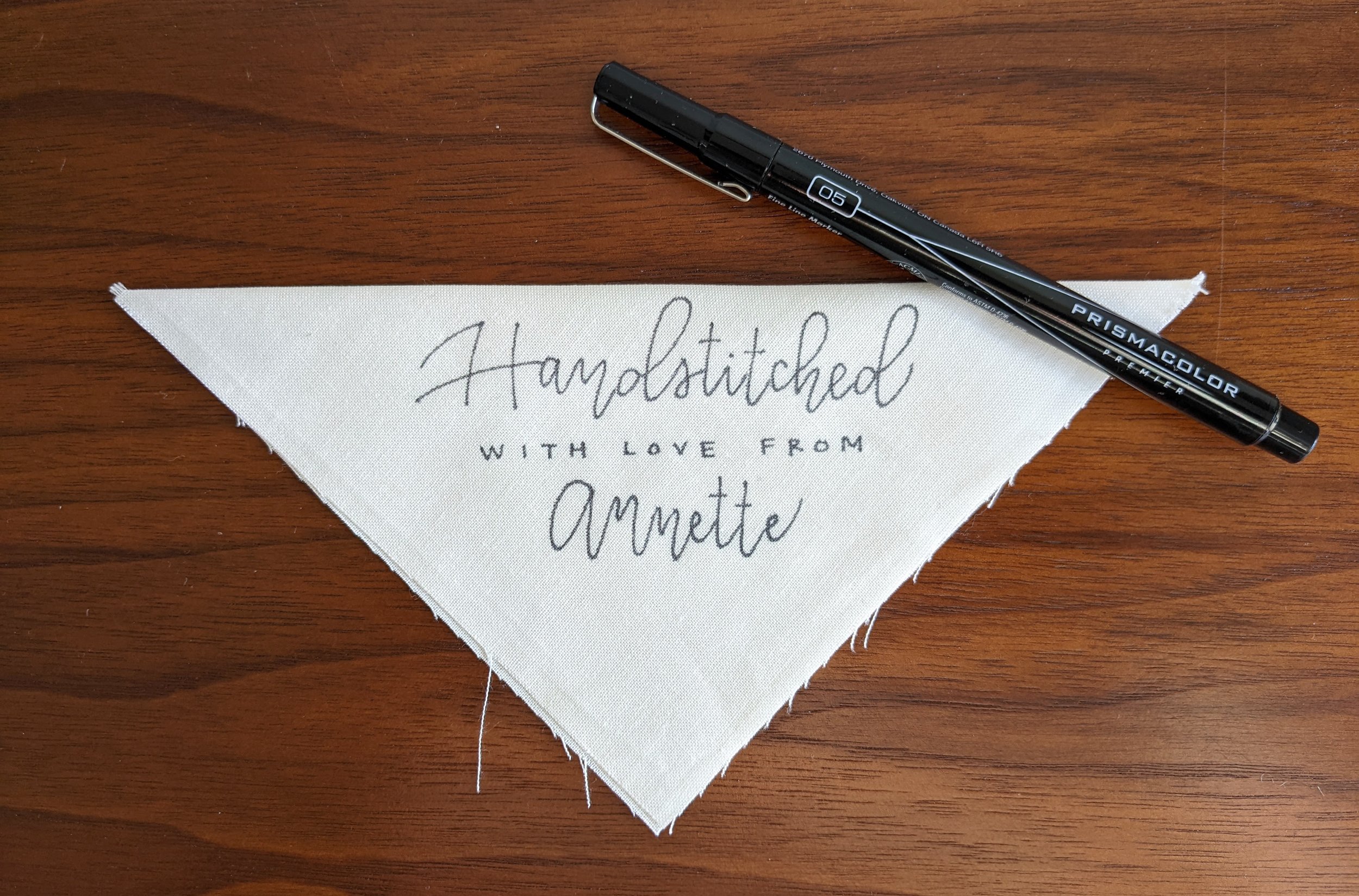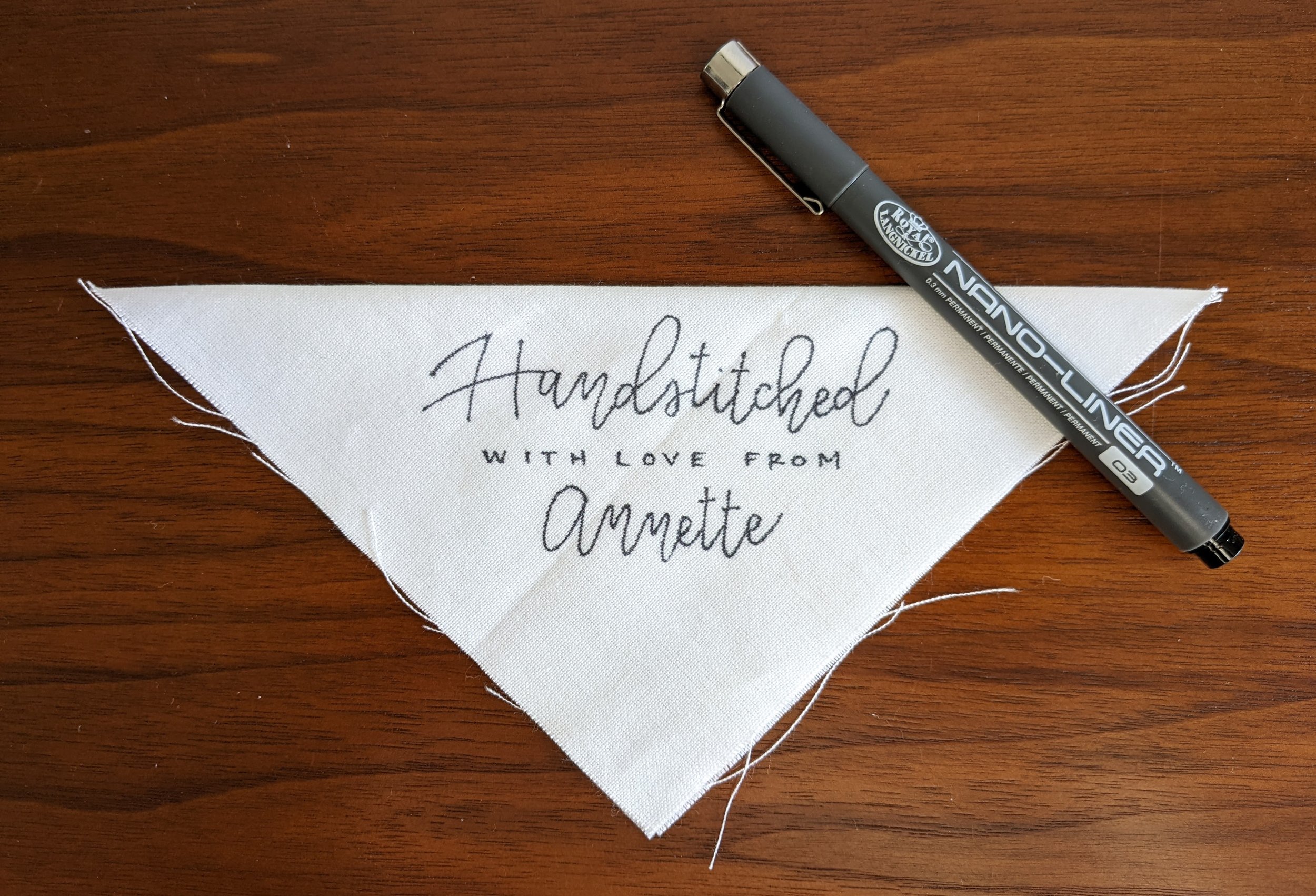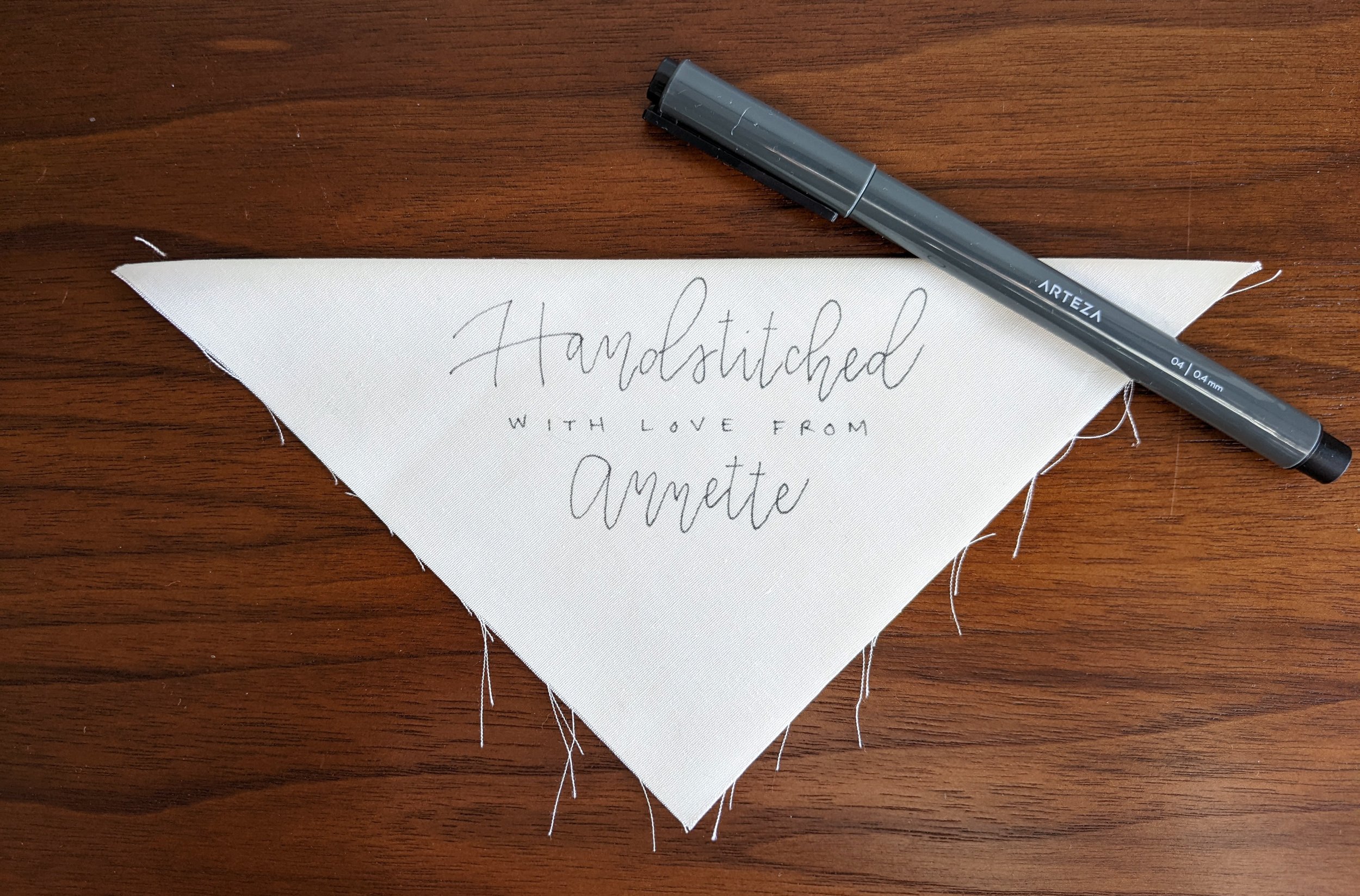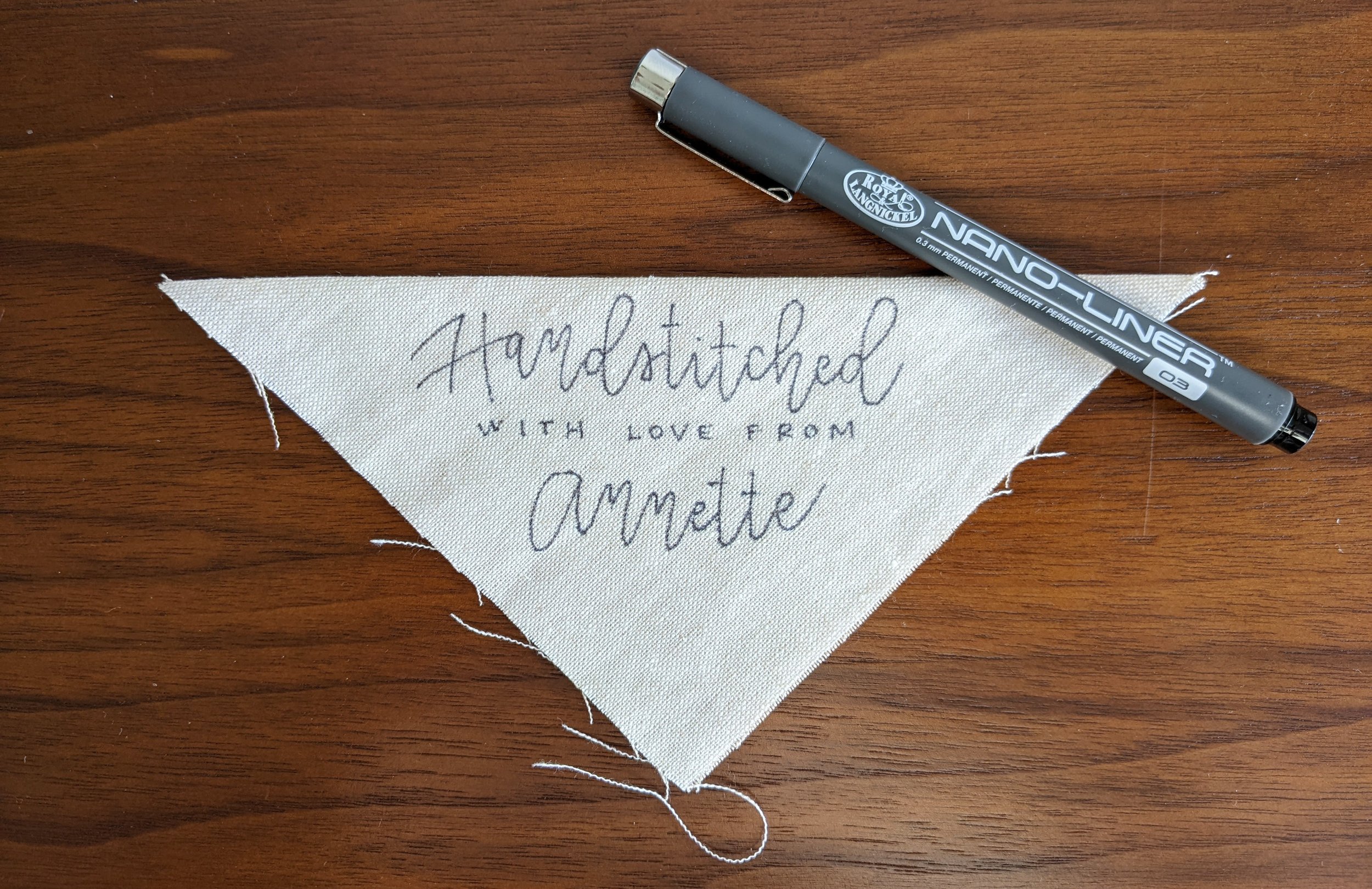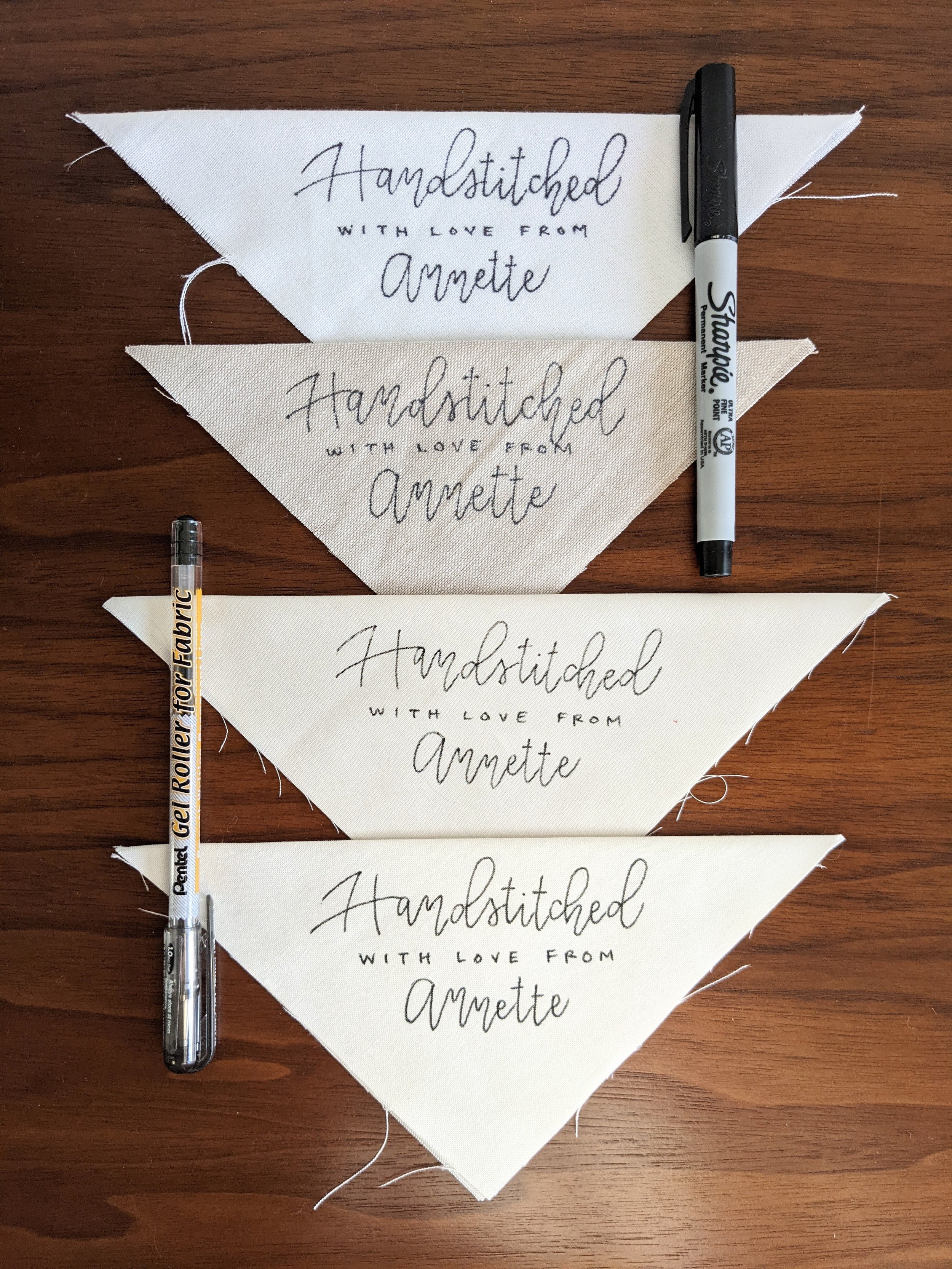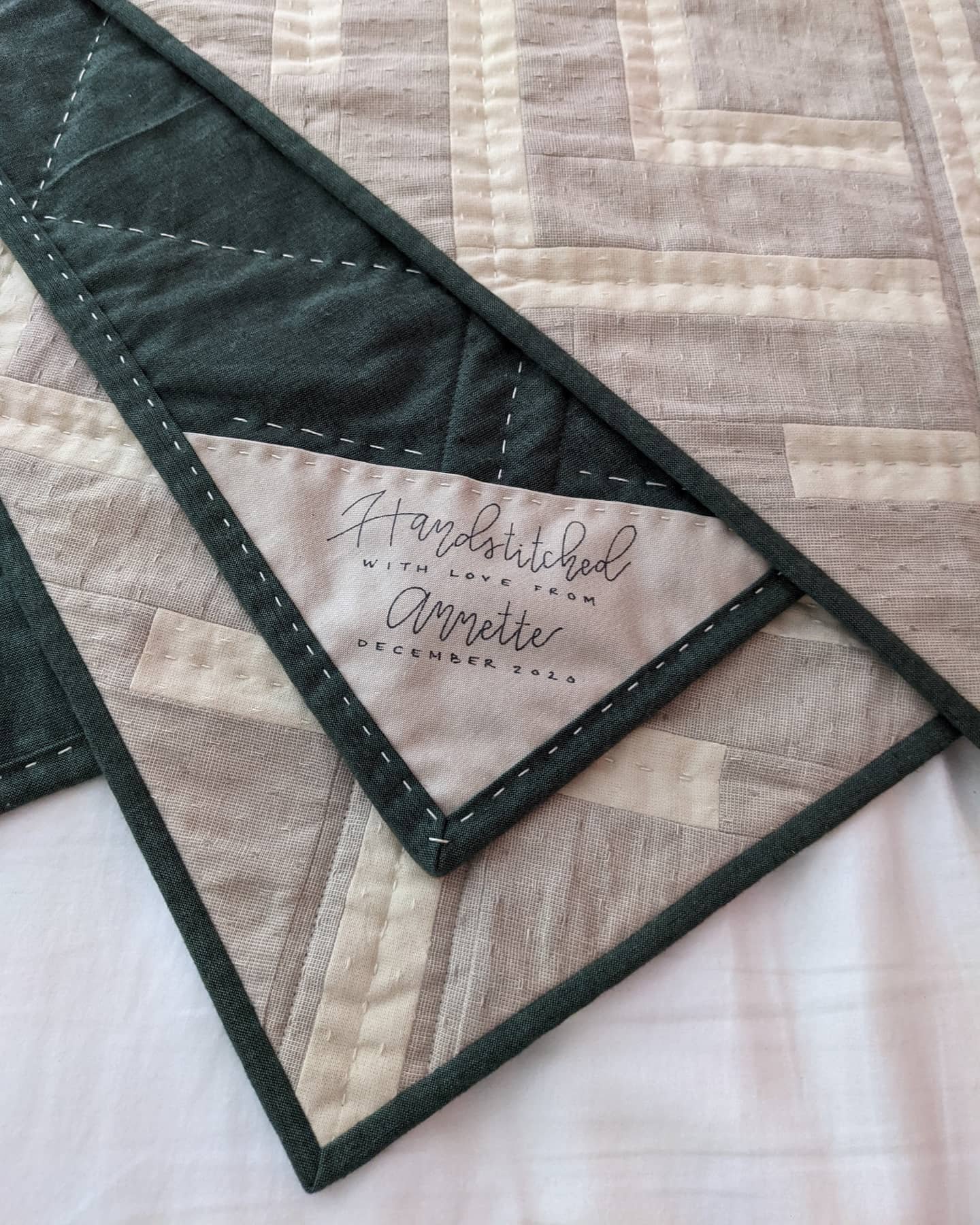The Best Pens for labeling Quilts
Here it is! The semi-definitive blog post on quilt labeling pens.
There is a lot to consider when choosing a labeling pen, which can make it daunting to choose one pen from the many. And what I’ve realized is that each type of fabric takes ink very differently, so one pen might not even be enough! So where do we start? Instead of pens, let’s start with the fabric. I don’t know about you, but I like to use a lot of different types of fabric when I quilt, and I typically match my label fabric to my quilt fabric. So, I chose my four most commonly used fabrics to test:
Kona Cotton from Robert Kaufman (in bone)
Essex Linen from Robert Kaufman (in flax)
Art Gallery Fabric Pure Solids (in creme de la creme)
Peppered Cottons from Studio E (in sand)
The five criteria I tested were:
Bleed: how much or how little each marker bled into the fabric
Writability: how easy or hard it was to write with normal pressure
Thickness: how thin or thick the line was that the pen made
Coverage: how light or dark the ink appeared when written
Fade: how the ink held up after washing
I wanted this experiment to be as true to my typical labeling practices as possible, so I followed these steps when testing each marker:
First, I stretched the fabric out and taped it to the table to make it easier to write on. I used a cursive font, which is my typical go to for labeling, and wrote out the name and weight (when applicable) of each pen. After writing on all four fabric types, I waited at least an hour and then pressed each fabric with a hot iron to heat set the ink. I then washed the fabric in various loads of laundry on the same settings I would use for a quilt: gentle cycle with cold water and a color catcher or two, then tumble dry on low heat. The results were actually quite interesting!
The above photo is all four fabrics immediately after writing and heat setting them. I then washed, dried, and pressed each fabric a total of five times, making a mark to record each wash and taking a picture to track the fade progress. You can see in the photos below how the pens fared on each fabric through all five wash cycles:
(Note that in wash 2, AGF and Kona are swapped - oops!)
Now let’s break down the overall performance of each of these fabrics:
Kona Cotton is my most used labeling fabric, mostly because it’s my fabric of choice for solids in a quilt. You can see from the image above that it takes ink very well. Almost all the pens had great coverage and were fairly easy to write with on this fabric. There was some bleed, but certainly not the worst. Pens tended to show up thicker on Kona than on any of the other fabrics. After washing, Kona held the ink the best compared to the other fabrics - after five cycles, there was barely any discernible fade(!).
Pros: takes ink well, good ink coverage, easy to write on, holds up well to washing
Cons: tends to bleed more than other fabrics
Peppered Cotton is another one of my preferred labeling fabrics. It’s soft and cozy to quilt with and was the easiest to write on. It was also, by far, the best when it came to bleeding. There was almost no perceptible bleed with even Sharpie or Nano-Liner pens, which usually cause the worst bleed of any of the pens I tested. Coverage was good, but not quite as good as Kona. After going through the wash, peppered cotton did okay. Some pens held up very well, while others nearly disappeared.
Pros: easiest to write on, no bleed, takes ink fairly well
Cons: doesn’t hold up well to washing for all pen types
Art Gallery Fabrics (AGF) is not typically my solid of choice, but I know it’s the favorite of a lot of quilters and always feels so luxurious! Unfortunately, this one was the hardest to find a good pen for. It bled the worst of any fabric and was rather difficult to write on, with the pens catching often on the fabric. Coverage was pretty good overall, but nothing to write home about. What AGF did very well was hold onto ink through the wash. There were a couple of pen types - usually the very thin ones - that faded quite a bit, so Kona was still number one in this area, but AGF was a solid contender.
Pros: decent ink coverage, holds up well to washing
Cons: bleeds a lot, very difficult to write on
Essex Linen is another one of my favorite fabrics because of the interesting texture. With that said, this one proved just as tricky as AGF to find a good pen, but for very different reasons. Most pens did not bleed with the linen, but the coverage was poor - it definitely had a hard time holding onto the ink. This fabric was also by far the most difficult to write on, catching almost every pen constantly, which made it very frustrating to try to get a smooth line. And when it came to being washed, almost no pen passed the test, fading to barely discernible lines.
Pros: no bleed
Cons: very difficult to write on, poor coverage, does not hold up to washing
Now that you’re familiar with the different fabrics and how well they performed for labeling, let’s look at the list of pens that were in the running:
Sharpie Ultra Fine Point
Prismacolor Premier, Fine Line (weights 03, 05, 08)
Nano-Liner Drawing Pen (weights 01, 02, 03, 05)
Dritz Fine Line Permanent Fabric Pen
Pentel Gel Roller for Fabric
Pigma Micron (weight 08)
Uchida Fabric Ball Marker
Uchida Fine Point Fabric Marker
Arteza Micro-Line Ink Pens (weights 02, 03, 04, 05, 08)
STA Pigment Liner (weights 0.3, 0.4, 0.5, 0.6, 0.8)
Many of these pens are not specifically made for fabric, but are permanent and hold up surprisingly well in the wash. As you can see, several of them come in a variety of weights. I didn’t use the smallest weights, and did not include them in the list above, as these were very difficult to work with and caught constantly on the fabric, so I ditched them, but I still used a range from very thin to very thick.
My original plan in this post was to talk about my favorite and least favorite pens and how they each performed, but I was surprised to learn that each pen performed very differently depending on the type of fabric it was used on (as you can see in pre- and post-wash photos above). So in order to spare you from information overload, I will instead break down my favorite pens for each fabric type, and then my favorite overall pens.
Kona: Prismacolor Premier
There were a lot of pens that performed well with Kona, so there are a lot of options to choose from, but my favorite was Prismacolor. The lines were clean and solid, with no bleeding, and it was easy to write with. Plus, it held up great in the wash, no matter what weight I wrote with! It comes in a variety pack, so if you like your writing to be thick or thin, there’s a weight for you. I prefer thinner lines and liked the 03 or 05 best. Above is my Kona label with Prismacolor Premier, Fine Line, size 05.
Peppered Cotton: Nano-Liner
For peppered cotton, my favorite was Nano-Liner. Many of the other pens faded away on this type of fabric, but Sharpie and Nano-Liners held up to multiple washings and stayed crisp and clean. What gave Nano-Liner the edge is that it was a much smoother writing experience, came in a variety of weights, and had less tendency to bleed like Sharpie. However, it is a bit harder to come by, so if you’re having trouble finding it, Sharpie is a solid back up. Above is my pepped cotton label using the Nano-Liner Drawing Pen, size 03.
Art Gallery Fabrics (AGF): Arteza
The trick with AGF was finding a pen that would not fade, but also not bleed all over the fabric. My choice for this fabric was Arteza, specifically sizes 04, 05 and 08. There was zero bleeding with these pens, with smooth and crisp lines that remained that way after several washes. The smaller weight, 02 and 03, had a harder time with fading. Prismacolor was my second choice for this fabric, but didn’t write with as crisp of a line. Above is my AGF label with Arteza Micro-Line size 04.
Essex Linen: Nano-Liner
This was a hard one as almost every pen faded after washing on this fabric. There were a couple that held up fairly well, and, of those, my choice for linen would be the Nano-Liner. This one maintained a mostly crisp, black line post-washing, in almost every weight I tested. I would recommend weight 03 or 04, as the smaller weights had the most trouble with fading. This pen, however, is a bit harder to get a hold of, so if you’re looking for an alternative, I would go with Sharpie Ultra Fine or the Pentel Gel Roller. Both of these had some degree of fading, but both wrote smoothly and were still easy to read after several washes. Above is my Essex Linen label with Nano-Liner size 03.
Best Performance for Multiple Fabrics: Sharpie Ultra Fine or Pentel Gel Roller
Not everyone wants to buy 4 completely separate pens for labeling, so if you’re just looking for a single recommendation that will work fairly well on all fabric types, I have two recommendations: Sharpie Ultra Fine or Pentel Gel Roller. Both of these hold up well on all types of fabrics through multiple washes, and both write fairly smoothly. In both, though, there are compromises. Sharpie tends to bleed, especially on fabrics like Kona and AGF, but if you use a light touch, you can make it work. The Pentel Gel Roller does not bleed, but is a very thick pen, which won’t be preferred by everyone, and doesn’t hold up as well on all types of fabric after washing (this one had trouble on AGF and linen). Above is my peppered cotton and Essex linen labels using Sharpie Ultra Fine, and my AGF and Kona labels using Pentel Gel Roller.
Get Sharpie Ultra Fine here
Get Pentel Gel Roller here
There you have it! My breakdown of labeling pens and how each of these pens fared in my pseudo-scientific testing. Hopefully this helps you in your label making endeavors and narrows down which pens may work best for your project. Let me know in the comments if you have a favorite fabric pen that wasn’t listed here. I’m always on the lookout for the perfect one!
Happy labeling!
Note: This post may contain affiliate links and I may earn a small commission when you click on the links, at no additional cost to you. As an Amazon Affiliate, I earn from qualifying purchases.

